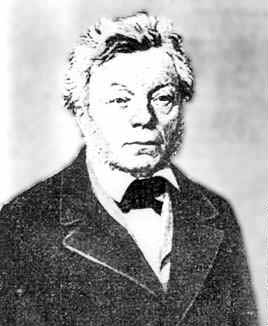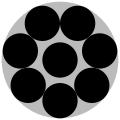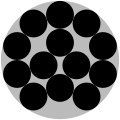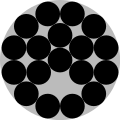
Packing problems are a class of optimization problems in mathematics that involve attempting to pack objects together into containers. The goal is to either pack a single container as densely as possible or pack all objects using as few containers as possible. Many of these problems can be related to real-life packaging, storage and transportation issues. Each packing problem has a dual covering problem, which asks how many of the same objects are required to completely cover every region of the container, where objects are allowed to overlap.

In geometry, the golden angle is the smaller of the two angles created by sectioning the circumference of a circle according to the golden ratio; that is, into two arcs such that the ratio of the length of the smaller arc to the length of the larger arc is the same as the ratio of the length of the larger arc to the full circumference of the circle.

In geometry, a sphere packing is an arrangement of non-overlapping spheres within a containing space. The spheres considered are usually all of identical size, and the space is usually three-dimensional Euclidean space. However, sphere packing problems can be generalised to consider unequal spheres, spaces of other dimensions or to non-Euclidean spaces such as hyperbolic space.
In geometry, the kissing number of a mathematical space is defined as the greatest number of non-overlapping unit spheres that can be arranged in that space such that they each touch a common unit sphere. For a given sphere packing in a given space, a kissing number can also be defined for each individual sphere as the number of spheres it touches. For a lattice packing the kissing number is the same for every sphere, but for an arbitrary sphere packing the kissing number may vary from one sphere to another.

In geometry, the Malfatti circles are three circles inside a given triangle such that each circle is tangent to the other two and to two sides of the triangle. They are named after Gian Francesco Malfatti, who made early studies of the problem of constructing these circles in the mistaken belief that they would have the largest possible total area of any three disjoint circles within the triangle.

Karl Georg Christian von Staudt was a German mathematician who used synthetic geometry to provide a foundation for arithmetic.
László Fejes Tóth was a Hungarian mathematician who specialized in geometry. He proved that a lattice pattern is the most efficient way to pack centrally symmetric convex sets on the Euclidean plane. He also investigated the sphere packing problem. He was the first to show, in 1953, that proof of the Kepler conjecture can be reduced to a finite case analysis and, later, that the problem might be solved using a computer.
In mathematics, real algebraic geometry is the sub-branch of algebraic geometry studying real algebraic sets, i.e. real-number solutions to algebraic equations with real-number coefficients, and mappings between them.

In geometry, circle packing is the study of the arrangement of circles on a given surface such that no overlapping occurs and so that no circle can be enlarged without creating an overlap. The associated packing density, η, of an arrangement is the proportion of the surface covered by the circles. Generalisations can be made to higher dimensions – this is called sphere packing, which usually deals only with identical spheres.
Circle packing in a square is a packing problem in recreational mathematics, where the aim is to pack n unit circles into the smallest possible square. Equivalently, the problem is to arrange n points in a unit square aiming to get the greatest minimal separation, dn, between points. To convert between these two formulations of the problem, the square side for unit circles will be L = 2 + 2/dn.
Square packing is a packing problem where the objective is to determine how many congruent squares can be packed into some larger shape, often a square or circle.
Circle packing in an equilateral triangle is a packing problem in discrete mathematics where the objective is to pack n unit circles into the smallest possible equilateral triangle. Optimal solutions are known for n < 13 and for any triangular number of circles, and conjectures are available for n < 28.
Karl August Reinhardt was a German mathematician whose research concerned geometry, including polygons and tessellations. He solved one of the parts of Hilbert's eighteenth problem, and is the namesake of the Reinhardt polygons and the Reinhardt conjecture on packing density.
In geometry, sphere packing in a cube is a three-dimensional sphere packing problem with the objective of packing spheres inside a cube. It is the three-dimensional equivalent of the circle packing in a square problem in two dimensions. The problem consists of determining the optimal packing of a given number of spheres inside the cube.

Ulam's packing conjecture, named for Stanisław Ulam, is a conjecture about the highest possible packing density of identical convex solids in three-dimensional Euclidean space. The conjecture says that the optimal density for packing congruent spheres is smaller than that for any other convex body. That is, according to the conjecture, the ball is the convex solid which forces the largest fraction of space to remain empty in its optimal packing structure. This conjecture is therefore related to the Kepler conjecture about sphere packing. Since the solution to the Kepler conjecture establishes that identical balls must leave ≈25.95% of the space empty, Ulam's conjecture is equivalent to the statement that no other convex solid forces that much space to be left empty.

Lebesgue's universal covering problem is an unsolved problem in geometry that asks for the convex shape of smallest area that can cover every planar set of diameter one. The diameter of a set by definition is the least upper bound of the distances between all pairs of points in the set. A shape covers a set if it contains a congruent subset. In other words the set may be rotated, translated or reflected to fit inside the shape.
David Anthony Klarner was an American mathematician, author, and educator. He is known for his work in combinatorial enumeration, polyominoes, and box-packing.
In geometry, it is an unsolved conjecture of Hugo Hadwiger that every simplex can be dissected into orthoschemes, using a number of orthoschemes bounded by a function of the dimension of the simplex. If true, then more generally every convex polytope could be dissected into orthoschemes.



















































